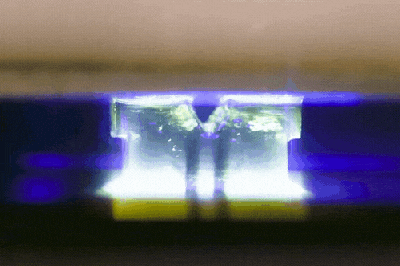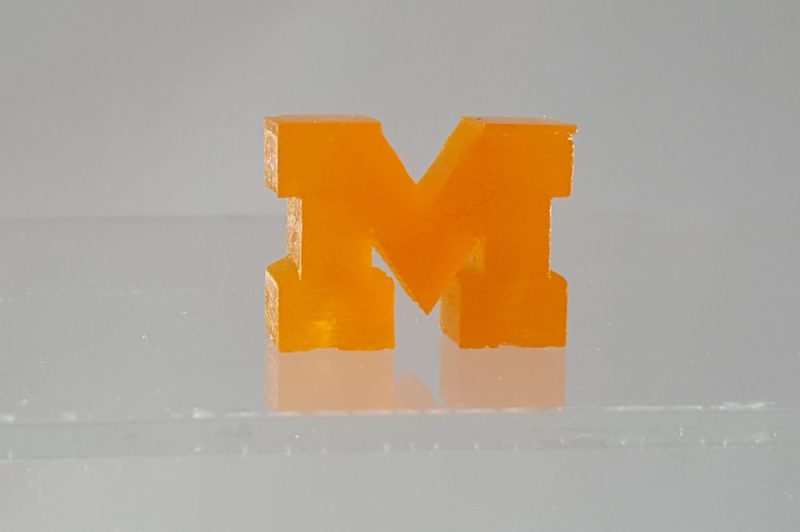3D printers now come in all shapes and sizes, and use a range of technologies to take a raw material and turn it into a solid object. We’re most familiar with Additive Manufacturing – where the object is created layer by layer. This approach is quite useful, but has a down side of being time consuming. Two professors at the  University of Michigan have figured out a way to speed this process up, big time.
University of Michigan have figured out a way to speed this process up, big time.
They start off with a VAT additive printing approach. These work by using an ultraviolet laser to harden or cure specific areas in a vat of resin, layer by layer, until the object is complete. The resin is then drained revealing your 3D printed object. Traditionally, VAT printing has been limited to small objects because the resin needs to have a relatively low viscosity.
The clever professors at U-M were able to get around this problem by adding a second laser that keeps the resin in a liquid state. By combining a curing laser with an ‘uncuring’ laser, they’re able to use resins that are more viscous, allowing them to print more durable parts. And do so about 100 times faster than traditional printers!
Thanks to [Baldpower] for the tip!
















Anyone else reminded of the “3d printer” skit from the Carbonaro Effect with it’s system of “one laser that heats the plastic up and another that cools it”?
Butterflügen!
I didn’t see the skit, but I’m sure he pulled it off well.
As an aside, aren’t lasers sometimes used to “reach” Absolute Zero?
Generally only 10^-9 Kelvin, but yes. That is the temperature of a particle of a speed that when hit by a single photon, doesn’t just slow down, but starts going the other way (i.e. has half the momentum of a photon)
Anybody else wonder why they didn’t print a shark?
Sorry, I’ll get my coat.
Wait, I’ll join you!
Mnm
“We’re most familiar with Additive Manufacturing – where the object is created layer by layer.”
Additive manufacturing refers to any process where a part is made by adding material, as opposed to subtractive manufacturing where a part is made by removing material. It’s still additive manufacturing if not done layer by layer.
That is uselessly pedantic.
Being correct is useless? And you push that on this site?
“You’re not wrong, Walter. You’re just an asshole.”
And if you read the very next sentences, you’ll see that they don’t say otherwise:
“This approach is quite useful, but has a down side of being time consuming. Two professors at the University of Michigan have figured out a way to speed this process up, big time.”
I.e. speeding up additive processing.
I’d agree with you. That’s not overly pedantic.
Cool! It reminds me of some TRIZ principles – “(3) local quality” , “(9) preliminary anti action” and even “(13) the other way round”
That reminds me that a better translation of “Preliminary anti action” is “anticipatory counteraction”. Now if only websites about TRIZ could be updated.
I think Will the writer of this article needs to re read what he’s linking to.
“Their method solidifies the liquid resin using two lights to control where the resin harden—and where it stays fluid. This enables the team to solidify the resin in more sophisticated patterns.”
This suggests to me they are using the 2 light sources to combine in one point to cure the resin.
Not one to cure and one to keep it liquid.
Unlike the usual method of a single light source from below.
Woops just found the bit about the photo inhibitor.
My tablet was bouncing bits of text and images all over the place while I was still reading it.
Apologies.
mmm crow; warm, cold, 9 days old still tastes like crap.
Still, it’s not clear to me how it works. It doesn’t sound like a laser is used to reliquify just inhibits certain areas to harden. It says it can now work in a volume millimeters from the glass window instead of a single layer very close to the window as older technology does, with the risk of getting solid resin stuck to the window, stopping the process dead in its track.
It increases the inflow of the resin, hence the speed up. So basically it can solidify a couple of mm at a time before moving the platform up to make room for more?
You’re right on the laser/light usage. It’s basicly creating an exclusion zone, similar to Carbon3d and CLIP (which uses oxygen and an oxygen permeable film) except it’s measured in MM instead of 100ths of MM. It still cures one thin layer at a time.
You can find your answers by following the link to the paper. There are no lasers used. There is a blue DLP projector which acts to inhibit curing, and a UV beam (based on the picture… not moving and not masked) which cures the resin wherever there isn’t blue light. By modulating the intensity of the blue light, they can actually cure a three-dimensional layer… pretty freaky!
http://advances.sciencemag.org/content/5/1/eaau8723/tab-figures-data
In fact it’s the other way around, the UV beam is the one that does the inhibition. The photoinitiator is sensible to the blue light.
(PS: it’s funny how the article on the own michigan university web site only speak about the two professor and associate professor that are listen in the end of the academic paper author list, but doesn’t acknowledge the work of the probably two PhD student listed as first author…)
I’ll try and explain it. So they use a dlp projector to display the slice in the resin, except they use the blue channel only, and instead of lighting up the slice they light up everything but the slice. They made a blue light mask. The platform that holds the print and gets dipped into the vat has a UV light source coming through it and it can only cure the resin that isn’t illuminated blue. They are using a special resin that seems to get blocked out of photo excitation in the blue band, but the unlit portions of the vat are free to cure by the UV light. Seems pretty simple, but technical at the same time. It means you can use highly viscous fluids because they don’t have to be runny enough to create a thin layer at the bottom of the vat.
Hail to the hackers!
Isn’t this ONO technology? The Kickstarter everyone backed (including me) yeaaars ago and they haven’t delivered -_-
That gif is not real time right? Probably sped up
The video at 6x is 18s long. I’m guessing just under 2 minutes for the print in the gif.
I’d swag 20mm over 108s meaning 180µm/s max print speed.
My partner works with the PhD student that did this work – Martin de Beer. It’s actually kind of funny, from what I gather he got a good deal of push-back from his professor when he was pitching this idea initially. He deserves a lot of credit for seeing it through, it’s really fascinating.
Huh, sounds like this resin system would work really well with crossed beams. Might even retro-fit to current SLA printers. Something as simple as a sheet of blue light to “mask” off the bottom few millimeters of the resin pool?
Never cross the streams
Probably not that simple. First it’s the other way around, the UV light do the inhibition, the blue light to the polimerization. And it’s generaly prefered to use near-UV or violet to do curing than blue, lower wavelength photon have more energy making it’s easier to do.
But more important, the increase of speed of this technique is made possible by the usage of grey level of the DLP projection system. Not possible with laser-based SLA, and difficult to do with a projection based printed that was not made to be used in grey level…
The idea is to do not a single “binary” layer of a fixed height per shot, but a thicker “3D” layer for each shot.
I just want to share this idea of mine:
Combine ultrasonic levitation technology with lasers and high speed machine vision in a 3D printer.
The printer drops a piece of plastic, cameras track the fall and the ultrasonic part guides it sideways to the position where it should end up. Lasers heat up the drop and the target area to melting point before impact for perfect adhesion. Machine vision may not be necessary, just assume everything goes fine.
and now this is in the public domain, it can never be patented
well, it’s maybe for the best.
now that i think of it, since the babel library is public(i guess) and contains every book, thus every idea… the patent system in a fair amount of countries is doomed no?
I’m not sure it justifies the speed of light title… It isn’t as fast as shown. The link has a slower video that is 6x speed. Given the quality it’s not all that just yet. But it is an interesting piece of research.